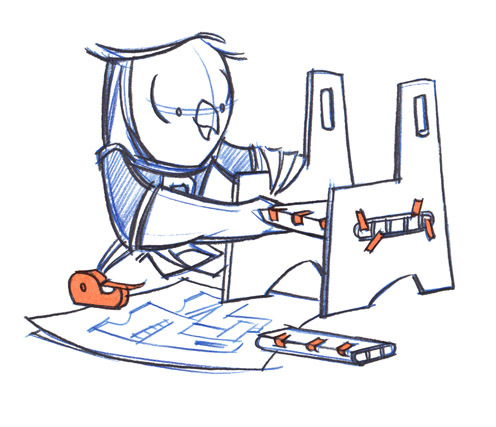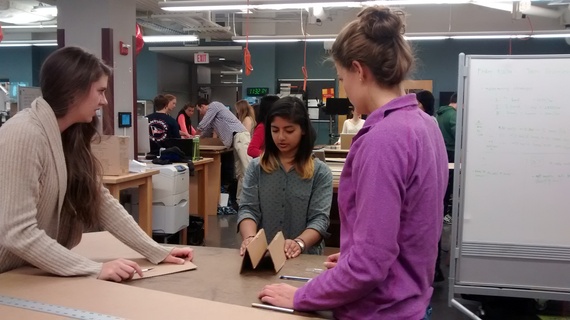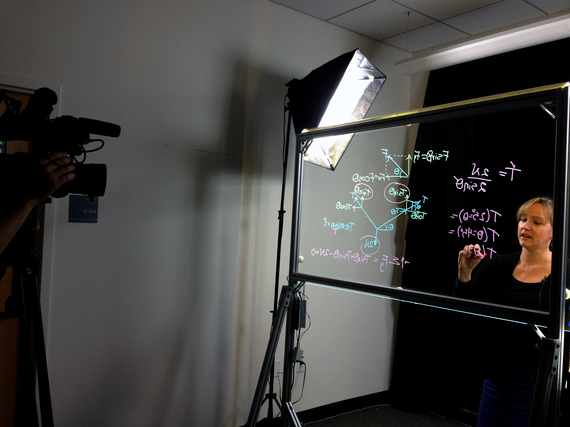What words comes to mind when you think about engineering? If you are like most people, words that come to mind include difficult and boring. In a study about teen perceptions of engineering, the most common word that teens used to describe engineering was difficult; boring was also popular among teens who knew little about engineering. Encouragingly, teens who had been exposed to engineering also used words like cool and gratifying. The study also found that most teens don't know much about engineering. When asked to explain what engineers do, people often report that engineers build bridges, buildings, and machines (assuming they don't say that engineers drive trains) but most people can't provide many details beyond that. And how about the difference between architects and engineers? Architects are creative and engineers crunch numbers, right? Hmm, I am an engineer and I do like to crunch numbers but I also love to be creative and engineering provides plenty of opportunities for me to be creative.
A desire to help people of all ages, particularly K12 students, better understand engineering led me to develop a massive open online course, or MOOC. MOOCs are online courses offered by universities for free to the public. Each class is typically taken by thousands of people from around the world. While close one-on-one interaction between the instructor and students is not possible with so many students in each course, rich online discussions between students from around the world are possible. And while students don't typically get university credit for courses, they can earn a certificate and will soon be able to earn credit for certain courses.
I am currently developing a MOOC entitled The Engineering of Structures Around Us, which will start on May 5, 2015. The course is targeted at high school students and others interested in better understanding engineering and the structures around them, from bridges and buildings in their communities to famous structures around the world. Why and how are structures designed? How do they support loads? And where do forces flow through them? What is the difference between an engineer and an architect? These are some of the questions we'll explore in the course. While the course includes some math, basic geometry and algebra, most of the concepts are accessible by anyone - you can skip the math if you wish though I hope some people find they like the math too.
So what does the course include? Like most MOOCs, the course includes short videos (most of the videos or mini-lectures are 3-8 minutes long) and questions to answer. The video producers have included lots of great images and animations in the videos and the questions include some fun matching and identification questions along with standard multiple choice and essay questions. But our team - we have a huge team of people from across campus working on the MOOC - wanted the course to be more than a collection of videos and questions. We wanted the course to be active and hands-on; a
confirms that active learning results in better performance in science, math and engineering courses. We wanted to make the course active and we also wanted to make engineering more approachable. So we included many aspects that not all MOOCs include such as illustrations, simulations, hands-on activities, mathematical explanations using a
, and the sharing of structures.
- Illustrations: Author and illustrator Katherine Roy developed a series of illustrations for the MOOC, with Owl as the central character. Owl has a problem each week that is solved using concepts from the course. We hope that this illustrated narrative will provide context for the ideas presented, generate student questions, and make engineering a bit more approachable.

Hands-on Activities: Incorporating hands-on activities was important to us as a way for students to learn and better understand how structures fit together and behave. The course includes several hands-on activities from designing and building a chair out of cardboard, to a model of a cable-stayed bridge to a tensegrity sculpture. We've tried to suggest easy to find materials for the activities such as cardboard, spaghetti and tape. And we've even put together 500 activity kits that we plan to distribute to a randomly selected group of students in the course. We are trying to provide lots of guidance for each activity but we also hope that students will be creative. 
Simulations: As another way to experiment with structures, David Souther with Third Cat, LLC, is working with us to develop a series of simulations. The simulations include one that allows the learners to experiment to determine how much load different columns can support and one to show how the mass and stiffness of a building affects its response. We see the simulations as another way to experiment and learn actively.Lightboard: Jared Benedict, a member our team, said we HAD to use a Lightboard and was instrumental in getting one built. Using the Lightboard I write directly on a piece of glass, which allows me to remain facing the students. 
Share your World: For each of the six concepts in the course we encourage learners to 'Share Your World' by taking pictures of structures in their world and discussing how these structures relate to the course.Which of these activities will engage the learners? Which will result in greater learning? We hope to find out. Will students participate in the discussions? Will they design and build and then post and discuss their designs? We hope so!
Developing the MOOC has been much more time-consuming than I anticipated (and I thought I had anticipated the fact that it would be a lot of work). But our whole team is hopeful that it will be a great experience for the learners and we hope to see many of you online, exploring the engineering of structures around us together. I believe that everyone can and should understand a few basic engineering concepts.
Support HuffPost
Our 2024 Coverage Needs You
Your Loyalty Means The World To Us
At HuffPost, we believe that everyone needs high-quality journalism, but we understand that not everyone can afford to pay for expensive news subscriptions. That is why we are committed to providing deeply reported, carefully fact-checked news that is freely accessible to everyone.
Whether you come to HuffPost for updates on the 2024 presidential race, hard-hitting investigations into critical issues facing our country today, or trending stories that make you laugh, we appreciate you. The truth is, news costs money to produce, and we are proud that we have never put our stories behind an expensive paywall.
Would you join us to help keep our stories free for all? Your contribution of as little as $2 will go a long way.
Can't afford to donate? Support HuffPost by creating a free account and log in while you read.
As Americans head to the polls in 2024, the very future of our country is at stake. At HuffPost, we believe that a free press is critical to creating well-informed voters. That's why our journalism is free for everyone, even though other newsrooms retreat behind expensive paywalls.
Our journalists will continue to cover the twists and turns during this historic presidential election. With your help, we'll bring you hard-hitting investigations, well-researched analysis and timely takes you can't find elsewhere. Reporting in this current political climate is a responsibility we do not take lightly, and we thank you for your support.
Contribute as little as $2 to keep our news free for all.
Can't afford to donate? Support HuffPost by creating a free account and log in while you read.
Dear HuffPost Reader
Thank you for your past contribution to HuffPost. We are sincerely grateful for readers like you who help us ensure that we can keep our journalism free for everyone.
The stakes are high this year, and our 2024 coverage could use continued support. Would you consider becoming a regular HuffPost contributor?
Dear HuffPost Reader
Thank you for your past contribution to HuffPost. We are sincerely grateful for readers like you who help us ensure that we can keep our journalism free for everyone.
The stakes are high this year, and our 2024 coverage could use continued support. If circumstances have changed since you last contributed, we hope you’ll consider contributing to HuffPost once more.
Already contributed? Log in to hide these messages.


